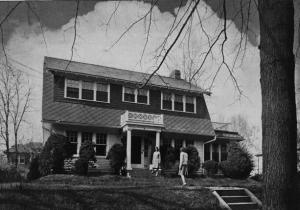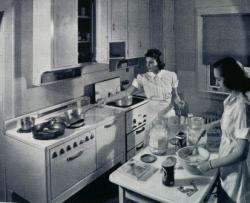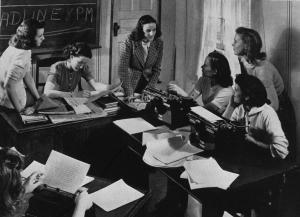Adding a "Domestic Practice House"
In the 1930s and 40s, the curriculum would continue to include home economics, but more emphasis would be placed on an academic program that would provide them with choices after graduation: continuing their education at a four-year college, taking a job in the paid workforce, or becoming a homemaker. As enrollment grew, Chevy Chase added classrooms and dormitories to the main building.

In 1939, as evidence of the continued importance of home economics in the Chevy Chase curriculum, Mrs. Farrington purchased a single family home on Thornapple Street, to be used as a "domestic practice house" for the home economics department. Small groups of students would live at the house for short periods while taking their regular classes. They practiced planning meals, buying groceries, and budgeting household expenses. And like Chevy students in the past, they practiced their skills as hostesses.

The caption for this photo from a Chevy Chase Junior College catalogue describes the girls working in the domestic practice house kitchen:
The curriculum in this later period prepared Chevy students for further education or careers in fields such as Journalism or Secretarial Science. By 1930, office work had become a predominantly female occupation. Nevertheless, many students ended up married with children a few short years after graduating from Chevy Chase, and the purchase of the "domestic practice house" seems consistent with student expectations.
In 1938 the Washington Post published an article, "Chevy Chase Girls Favor Matrimony Over Careers," about a survey conducted by Alice Skinker and Anita Mammele, members of a journalism class at Chevy Chase. All 77 girls attending the school were asked if they preferred pursuing a career or matrimony. More than half (52 percent) of the Chevy students wanted to marry within a year of their graduation, and a majority of them also hoped to have children. According to the Post, the survey also found that
Of those students who wanted to work before marriage, 32 percent wanted to be journalists, 28 percent preferred office work, 19 percent wanted to work as interior decorators, 14 percent wanted to design clothing, and 9 percent hoped to be creative writers.

The changing expectations of Chevy Chase students in 1938 reflect the growing trend of women entering the paid workforce. In just a few years, many women would take non-traditional jobs during World War II. And despite their displacement after the war,many continued to work, both before and after marriage.
As Joan Russell wrote, without alumnae records, we can only imagine what jobs Chevy Chase graduates had -- "homemakers or business?" Or both? The debate continues.


